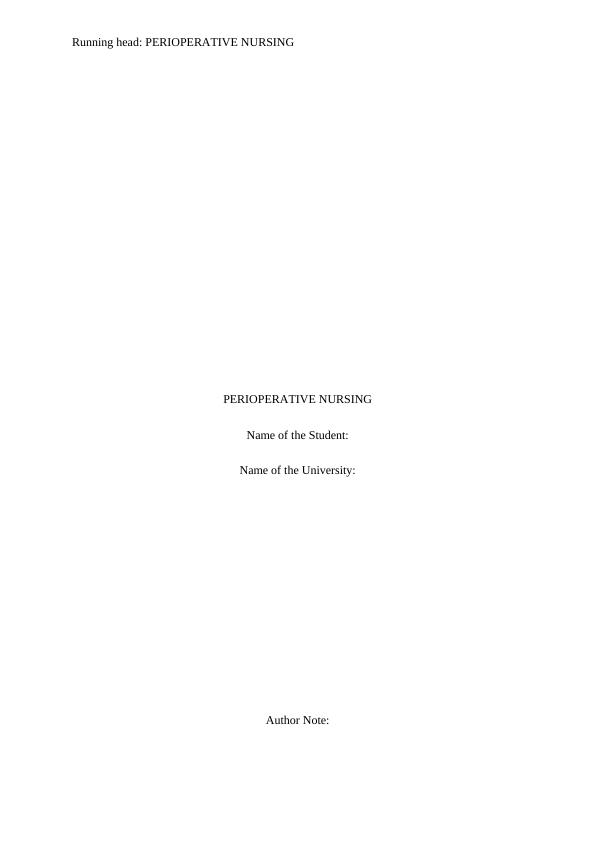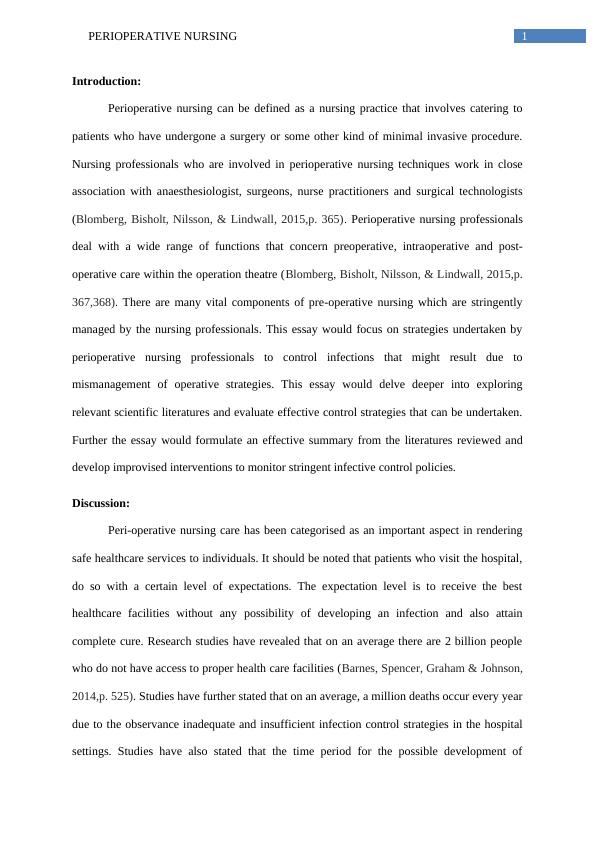Perioperative Nursing: Strategies for Infection Control
Added on 2023-06-05
10 Pages3001 Words99 Views
Running head: PERIOPERATIVE NURSING
PERIOPERATIVE NURSING
Name of the Student:
Name of the University:
Author Note:
PERIOPERATIVE NURSING
Name of the Student:
Name of the University:
Author Note:

1PERIOPERATIVE NURSING
Introduction:
Perioperative nursing can be defined as a nursing practice that involves catering to
patients who have undergone a surgery or some other kind of minimal invasive procedure.
Nursing professionals who are involved in perioperative nursing techniques work in close
association with anaesthesiologist, surgeons, nurse practitioners and surgical technologists
(Blomberg, Bisholt, Nilsson, & Lindwall, 2015,p. 365). Perioperative nursing professionals
deal with a wide range of functions that concern preoperative, intraoperative and post-
operative care within the operation theatre (Blomberg, Bisholt, Nilsson, & Lindwall, 2015,p.
367,368). There are many vital components of pre-operative nursing which are stringently
managed by the nursing professionals. This essay would focus on strategies undertaken by
perioperative nursing professionals to control infections that might result due to
mismanagement of operative strategies. This essay would delve deeper into exploring
relevant scientific literatures and evaluate effective control strategies that can be undertaken.
Further the essay would formulate an effective summary from the literatures reviewed and
develop improvised interventions to monitor stringent infective control policies.
Discussion:
Peri-operative nursing care has been categorised as an important aspect in rendering
safe healthcare services to individuals. It should be noted that patients who visit the hospital,
do so with a certain level of expectations. The expectation level is to receive the best
healthcare facilities without any possibility of developing an infection and also attain
complete cure. Research studies have revealed that on an average there are 2 billion people
who do not have access to proper health care facilities (Barnes, Spencer, Graham & Johnson,
2014,p. 525). Studies have further stated that on an average, a million deaths occur every year
due to the observance inadequate and insufficient infection control strategies in the hospital
settings. Studies have also stated that the time period for the possible development of
Introduction:
Perioperative nursing can be defined as a nursing practice that involves catering to
patients who have undergone a surgery or some other kind of minimal invasive procedure.
Nursing professionals who are involved in perioperative nursing techniques work in close
association with anaesthesiologist, surgeons, nurse practitioners and surgical technologists
(Blomberg, Bisholt, Nilsson, & Lindwall, 2015,p. 365). Perioperative nursing professionals
deal with a wide range of functions that concern preoperative, intraoperative and post-
operative care within the operation theatre (Blomberg, Bisholt, Nilsson, & Lindwall, 2015,p.
367,368). There are many vital components of pre-operative nursing which are stringently
managed by the nursing professionals. This essay would focus on strategies undertaken by
perioperative nursing professionals to control infections that might result due to
mismanagement of operative strategies. This essay would delve deeper into exploring
relevant scientific literatures and evaluate effective control strategies that can be undertaken.
Further the essay would formulate an effective summary from the literatures reviewed and
develop improvised interventions to monitor stringent infective control policies.
Discussion:
Peri-operative nursing care has been categorised as an important aspect in rendering
safe healthcare services to individuals. It should be noted that patients who visit the hospital,
do so with a certain level of expectations. The expectation level is to receive the best
healthcare facilities without any possibility of developing an infection and also attain
complete cure. Research studies have revealed that on an average there are 2 billion people
who do not have access to proper health care facilities (Barnes, Spencer, Graham & Johnson,
2014,p. 525). Studies have further stated that on an average, a million deaths occur every year
due to the observance inadequate and insufficient infection control strategies in the hospital
settings. Studies have also stated that the time period for the possible development of

2PERIOPERATIVE NURSING
infection due to casualty or negligence observed in the procedure of surgery can last from a
period of 2 weeks to almost a month (Barnes, Spencer, Graham & Johnson, 2014,p. 528) .
Major incidences of infection have been categorised as formation of blood clots in
different organs of the body, development of infection in the lungs, kidney and liver.
Probable incidences of developing post operative fever and ‘strokes’ have also been reported
in research studies (Berend et al., 2013, p. 515). It has been found that most of the infection
cases have resulted on account of critical complications arising after a difficult operation.
Mortality rates have been reported to be roughly three times higher in developing countries
than in developed countries primarily because of a major lacuna in managing risk factors and
infection control strategies in a proper manner (Berrios-Torres et al., 2017,p.790).
Mortality rates have been reported to be higher in procedures involving surgical
intervention. Moreover it has been found that mortality rate is lower in terms of developing
infections due to improper anaesthetic management (Berrios-Torres et al., 2017,p.790).
However, there have been several reports that have predicted the prevalence of mortality rates
arising due to improper administration of anaesthesia, causing an overdose. The overdose of
anaesthesia has led to the development of several complications such as pulmonary infection
and development of infection in the respiratory tract (Kwon et al., 2013, p. 8). Deaths have
been reported on account of blockage in the respiratory pathway. It has been reported that
catheter associated infection is the most common form of infection that affects patients
undergoing surgery in an ICU setting (Kwon et al.,2013, p.8,9) . Typically, it has been found
that catheter related infection development around the urinary tract develops on account of
manhandling or problems associated with the correct placement of the catheter in patients.
Research studies have also suggested that catheter infections can also arise on account of
infections caused by hospital pathogens (Poultsides et al., 2013,p. 387).
infection due to casualty or negligence observed in the procedure of surgery can last from a
period of 2 weeks to almost a month (Barnes, Spencer, Graham & Johnson, 2014,p. 528) .
Major incidences of infection have been categorised as formation of blood clots in
different organs of the body, development of infection in the lungs, kidney and liver.
Probable incidences of developing post operative fever and ‘strokes’ have also been reported
in research studies (Berend et al., 2013, p. 515). It has been found that most of the infection
cases have resulted on account of critical complications arising after a difficult operation.
Mortality rates have been reported to be roughly three times higher in developing countries
than in developed countries primarily because of a major lacuna in managing risk factors and
infection control strategies in a proper manner (Berrios-Torres et al., 2017,p.790).
Mortality rates have been reported to be higher in procedures involving surgical
intervention. Moreover it has been found that mortality rate is lower in terms of developing
infections due to improper anaesthetic management (Berrios-Torres et al., 2017,p.790).
However, there have been several reports that have predicted the prevalence of mortality rates
arising due to improper administration of anaesthesia, causing an overdose. The overdose of
anaesthesia has led to the development of several complications such as pulmonary infection
and development of infection in the respiratory tract (Kwon et al., 2013, p. 8). Deaths have
been reported on account of blockage in the respiratory pathway. It has been reported that
catheter associated infection is the most common form of infection that affects patients
undergoing surgery in an ICU setting (Kwon et al.,2013, p.8,9) . Typically, it has been found
that catheter related infection development around the urinary tract develops on account of
manhandling or problems associated with the correct placement of the catheter in patients.
Research studies have also suggested that catheter infections can also arise on account of
infections caused by hospital pathogens (Poultsides et al., 2013,p. 387).

End of preview
Want to access all the pages? Upload your documents or become a member.
Related Documents
The Concept of Surgical Site Infectionslg...
|3
|570
|73